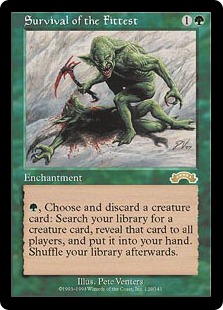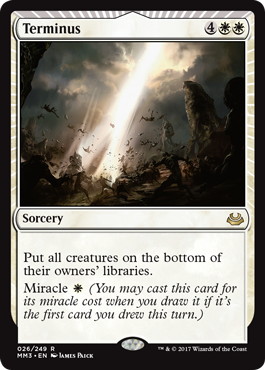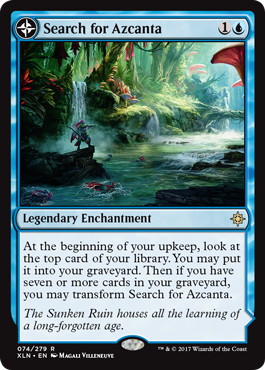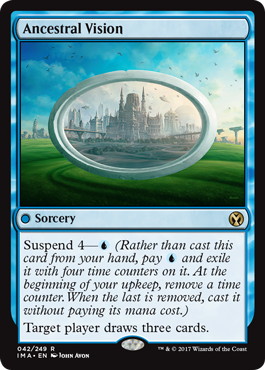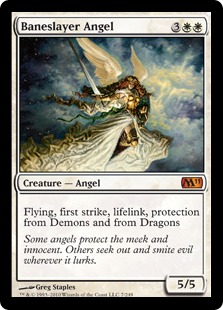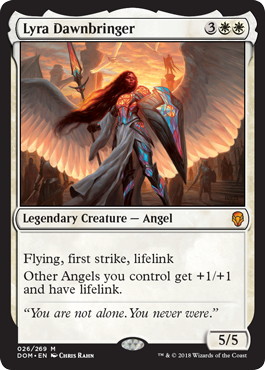Darwinism explained (poorly)
“It is not the strongest of the species that survives, not the most intelligent that survives. It is the one that is the most adaptable to change.”
― Charles Darwin
The Darwinian theory, or Darwinism, is a theory of biological evolution named after Charles Darwin, who explained it in “The Origin of Species”. It theorizes the mechanisms behind the evolution of species through time, and how one species can evolve over time depending on its natural habitat, predators and prey to better adapt its environment.
A heavily simplified and summarized version of could go like this:
Obviously, that environment itself is going to change: predators and prey will evolve as well, climate will change, perpetuating the need to evolve in order to remain “competitive” as a species. Not doing so will result in extinction – think Sabretooth Tiger, for example.
Well, I do not want my deck to be a Sabretooth Tiger – even though that would be a cool card to make.
Applying Survival of the Fittest to MTG
You might be wondering where are I am going with that. Actually, the idea behind my article came up during a discussion with other players about my Modern UW decklists. I have been playing it for a year, tested pretty much everything, and yet it keeps evolving. It also shows random numbers than I cannot justify through a rational explanation…except Darwinism.
- Pierre Dagen
- – UW Control
- GP Barcelona 2018
- (7th)
2 《Plains》
2 《Hallowed Fountain》
4 《Flooded Strand》
4 《Celestial Colonnade》
2 《Glacial Fortress》
1 《Mystic Gate》
4 《Field of Ruin》
-Land (25)- 3 《Snapcaster Mage》
1 《Vendilion Clique》
-Creature (4)-
4 《Path to Exile》
4 《Serum Visions》
1 《Opt》
1 《Condemn》
1 《Spell Snare》
2 《Logic Knot》
1 《Negate》
1 《Remand》
3 《Cryptic Command》
1 《Day of Judgment》
1 《Wrath of God》
2 《Terminus》
2 《Search for Azcanta》
1 《Detention Sphere》
2 《Jace, the Mind Sculptor》
1 《Gideon of the Trials》
2 《Teferi, Hero of Dominaria》
-Spell (31)-
2 《Rest in Peace》
2 《Stony Silence》
2 《Damping Sphere》
1 《Baneslayer Angel》
1 《Vendilion Clique》
1 《Celestial Purge》
1 《Disdainful Stroke》
1 《Negate》
1 《Timely Reinforcements》
1 《Settle the Wreckage》
-Sideboard (15)-
For example, I am playing exactly one 《Remand》 in most of my lists – I actually top8ed a GP (Barcelona) not long ago with it. People keep making fun of it, the lone 《Remand》 that is clearly not accomplishing anything specific and never shines in any match-up. Why do I have it? Well, my lists with one 《Remand》 seem to show a better ability to survive in the Modern environment, so that is a trait the passes on the next list when this brain baby of mine reproduces.
Actually, this happens on an infinitely larger scale: MTGO. How do you think MTG shapes up the metagame of any constructed format? Darwinism. Let us take a tribe – in this case, an archetype – like Modern UW control on MTGO. All the members of the tribe share the same general characteristics: they play Blue and White with countermagic, they run 4 《Path to Exile》 and 4 《Celestial Colonnade》, they play a bunch of 《Wrath of God》 effects and cantrips… Still, in the early stages, each individual member of the species (i.e. each specific decklist) has its own specific traits: one of them runs a 《Jace, Architect of Thought》, one is playing 4 《Terminus》 instead of a mix, one relies on 《Search for Azcanta》 for card advantage while the other one is running 《Ancestral Vision》.
But from that tribe, some individuals will survive and reproduce: the ones that will score a 5-0 finish in a league, or a top8 in an online PTQ, and get published. Their specific traits will grow more and more common as deckbuilders to realize they do provide an edge, and at some point, those specific traits will become the norm. Of course, due to variance (and to the faulty system that MTGO uses to select which decklists they publish, but this is not the point I want to discuss today), some flawed mutations will appear in a few 5-0 decklists – just like you do not need to be the most well adapted, most evolved member of your species to reproduce: you are just less likely to. But in the long run, those will be fewer and fewer as people inheriting those mutation (i.e. adapting the idea of a faulty decklist) are more likely to lose themselves, and so on.
- Mattia Rizzi
- – UW Control
- Pro Tour 25th Anniversary
- (9th)
2 《Plains》
2 《Hallowed Fountain》
4 《Flooded Strand》
4 《Celestial Colonnade》
2 《Glacial Fortress》
4 《Field of Ruin》
1 《Ghost Quarter》
-Land (25)- 2 《Snapcaster Mage》
-Creature (2)-
4 《Path to Exile》
4 《Opt》
1 《Condemn》
1 《Spell Snare》
2 《Negate》
1 《Think Twice》
1 《Logic Knot》
4 《Cryptic Command》
1 《Wrath of God》
1 《Supreme Verdict》
3 《Terminus》
2 《Detention Sphere》
2 《Jace, the Mind Sculptor》
2 《Teferi, Hero of Dominaria》
-Spell (33)-
2 《Dispel》
2 《Celestial Purge》
2 《Rest in Peace》
2 《Stony Silence》
2 《Damping Sphere》
1 《Baneslayer Angel》
1 《Lyra Dawnbringer》
1 《Negate》
-Sideboard (15)-
That is exactly what is happening to UW right now: 《Ancestral Vision》 was not a highly regarded card even 3 months ago, and 《Search for Azcanta》 had the most hype around it. But slowly, the few decklists that did run it online showed results, and more people tried, up to the point that it is now the more common choice and was a 4-off in Mattia Rizzi’s list that 9th in PT 25th Anniversary last month.
Conversely, when Thomas Mechin and myself ran 《Baneslayer Angel》 in our sideboard at GP Barcelona (the original idea came from Immanuel Gerchenson, I believe), almost no list had it; we finished 7th and 11th outside of about 1,200 players, and that trait quickly spread, up to the point where one 《Baneslayer Angel》 and one 《Lyra Dawnbringer》 is now the stock sideboard online.
Using Darwinism for Deckbuilding
This is all good and nice, but so what? Does it actually make any difference if the lists that shape the metagame are designed through an evolutionary process, or would it be the exact same thing if peanut-shaped aliens mailed it to Brad Nelson every Christmas morning?
Well, I think you can actually use this to your advantage – at least, I do. See, unlike the evolution of species which is mostly linear -it is highly unlikely that we “devolve” into a Brontosaurus, a Sabretooth Tiger or any great marine mammal , even though I would pay to see that- the evolution of eternal formats is mostly cyclical. Decks fall in and out of fashion, swapping predator and prey every now and then.
If you take note of which card started to appear in the list of a given archetype at which point, then you can instantly adapt as soon as you want to prey on a new environment (a new metagame). Basically, what I am saying is that if you intend to play the same deck for a long period of time (which should mostly apply to Modern and Legacy, since Standard rarely has time to go through more than one cycle before it changes forever), keep track! It is fairly easy to take notes on every trait you ever tried in your deck, and note which were is preys (i.e. the decks you were beating thanks to that tweak) and which were its predators (i.e. which decks were beating you because of that tweak).
Here is a very small part of my own, as an example, for Modern UW:
| Predators | Specific Trait | Preys |
|---|---|---|
| Humans, Spirits, Merfolk | 4th 《Cryptic Command》 | Mirror, Tron, KCI |
| Mirror, Storm, Tron, KCI, Affinity | Main Deck 《Timely Reinforcements》 | Burn, Hollow One, Humans |
| Humans, Jund, Company | 《Settle the Wreckage》 | Hollow One, Boggles, Affinity |
| Mirror, Hollow One | 《Search for Azcanta》 | Humans, Jund, Jeskai |
| Humans, Burn, Affinity | 《Ancestral Vision》 | Jund, Mirror, KCI |
| Tron, Jeskai, Burn | 《Jace, Architect of Thought》 | Mardu, Storm, KCI |
| Tron, Scapeshift | 《Dispel》 | Mirror, Jeskai, Burn, Storm |
| … | etc | … |
Before you go nuts, remember that the whole thing is written within the boundary of what my species is, i.e. keeping in mind that there is only so much tweaking you can do if you want to remain an UW deck. For example, you might be shocked that aggro decks like Humans or Hollow One do not appear among the “predators” for 《Dispel》. I mean, the cards does literally nothing against them, right? Right. But the thing is, whichever card I put in this sideboard slot, it will not do anything against Humans or Hollow One: it will be targeted at control and combo decks. Hence, it will take the place of a card like 《Negate》, which would be much worse against Storm where the one mana is very relevant, but infinitely better against Tron or Scapeshift where 《Dispel》 should have been 《Negate》 or 《Disdainful Stroke》.
Same goes for 《Search for Azcanta》: the card is not bad stuff in the mirror (it is obviously better than 《Terminus》…) but I would play it instead of another form of card advantage, and 《Search for Azcanta》 is the worse source of card advantage in the mirror because we both play four 《Field of Ruin》 – I like 《Ancestral Vision》 way better here, for example. Hence, if my list plays a bunch of 《Search for Azcanta》, I do concede a small edge in the mirror match.
Conversely, 《Search for Azcanta》 is definitely not a great card against Humans, but it is the best source of card advantage against them (outperforming 《Ancestral Vision》 by a ton, for example) because it can ramp me into 《Terminus》 and will surely go uncontested (no hate grave, no 《Pithing Needle》, no 《Field of Ruin》…). So, by choosing to use this trait instead of another 《Ancestral Vision》, I do give myself a little push towards beating Humans.
Conclusion
My own list is obviously much messier than the example (handwriting is not my forte), but I found it much easier to adapt quickly and not have to start from scratch since I started doing that. The results have been there, with a very good winrate in Modern this year, exclusively playing UW. If you have your own petdeck that you like, or are interested in adopting one, I can only advise you to do the same.
Until next time,
Pierre Dagen
Recommended Items



